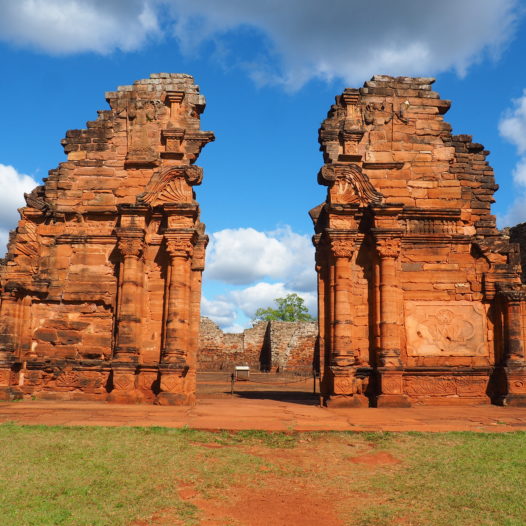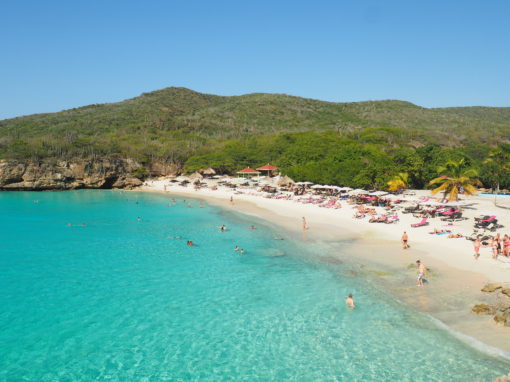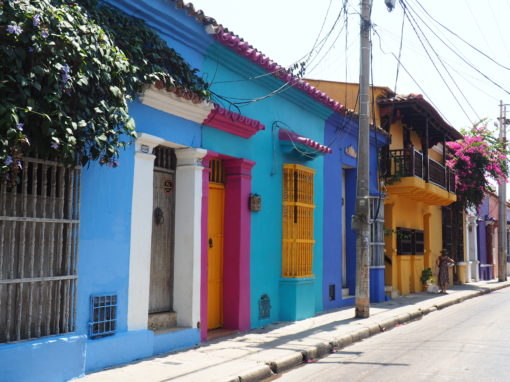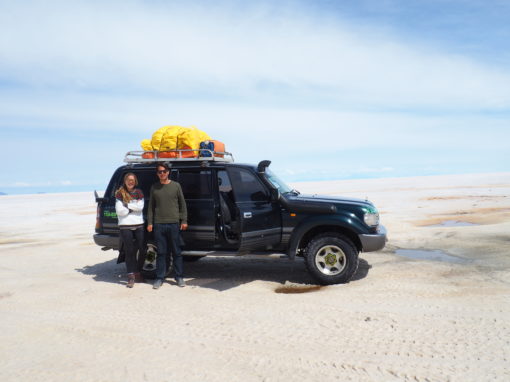WHAT: A visit to the religious settlement of the Jesuits in San Ignacio WHERE: In the town of San Ignacio - surrounded by dense tropical forests. About an hour away from Posadas. HOW MUCH: 200 pesos admission fee. One way bus from the main bus terminal in Posadas costs about 55-60 pesos. HOW LONG: Half a day will do. Count two hours for the visit to the sight itself and you'll have a lot of time to walk around. Restaurants are right outside of the area with the basic meals (chicken, pizza or 'milanesa') in case you get hangry afterwards.
When I was young I once saw “The Mission” – you know that eighties movie with Jeremy Irons and Robert De Niro? – and for some kind of reason it made a severe impression on me. I remember when I was at Iguacu (the giant waterfalls on the border of Argentina, Brazil and Paraguay) all I could think about was that shot were the giant cross with Jeremy Irons – if I remember correctly – on top of it suddenly falls from the top of the waterfall straight into the misty void. As I was suffering severely from extremely itchy bed bugs at the time I was just thinking of how nice jumping in all of that cold water must have felt like. Yes, they kind of eat out your brain too, those little nasty fellows.
It’s been five years and though I’m still freaking out whenever I hear someone saying ‘bed bug’ it feels good to be back on the other side of the majestic and dense jungle, on the Argentinian side. Since I didn’t get the chance last time; I finally grasped the opportunity during this trip to get a better understanding of the religious settlements of the jesuits in Latin America.
From the year 1609, the jesuits established in total some 30 missions around nowadays Argentina, Brazil and Paraguay, or ‘reducciones’ as they referred to it. From the Alto Perú area the jesuits (a fairly new order at the time) travelled south to Córdoba. Over there they established the center of their network. Córdoba was also the place where they founded the first university, now known as Universidad Nacional de Córdoba. From there they expanded east towards Paraguay.
Though the Jesuits tried to evangelize other parts of the country over the next 150 years, it was in this subtropical Upper Paraná where they had their bigger ‘success’ christianising or ‘civilising’ and educating the local native population. The bright side of it all – I guess – was that the Guaraní indians who lived and worked as their pupils would not be enslaved by the Portuguese in return. It might have been the reason why they decided to be under jesuit rule. Although people supposedly still were stolen from the reducciones as well.
The Guaraní were taught to read and write, not only in Spanish but also in Latin and Guaraní.
For every big community only a couple of jesuit priests would be present. The missions were largely self-sufficient settlements and the priests learned the Guaraní how to manage crops and cattle for example. The ‘enlightened approach’ of the jesuits is often mentioned while describing the actions of the jesuits, in contrast to the harsh methods elsewhere in Latin America. Work was organized on a cooperative basis and education and culture was an important part in mission life. The Guaraní were taught to read and write, not only in Spanish but also in Latin and Guaraní. Apparently the jesuits were the first to write down the language and stories of the Guaraní. On the downside many people died due to the diseases that the priests brought along.
Whether bad or good, the reducciones didn’t last long. Jesuits were becoming the subject of political resentment due to their ‘success’. Local enemies were also spreading word that the Jesuits were hiding valuable silver mines and that the jesuits priests were acting as agents of Spain’s enemies. Eventually both the Vatican and the Spanish crown questioned the jesuits’ power and loyalty and decided to stop supporting the jesuits and her colonies in 1767.
Forced to give up their missions after some resistance, the jesuit priests fled to Germany and Russia. Many slave traders afterwards attacked the missions, or they were taken over by other orders. Some Guaraní fled back to the jungle, although they were not used to the lifestyle anymore after four generations.
The buildings eventually fell into disuse, eventually as such goes in the tropics they were taken over by the jungle. With five of the missions nowadays enlisted on the UNESCO list, San Ignacio is one one of the bigger ones of them.
From the lovely town of Posadas it’s an easy ride from the main bus terminal to the small town of Posadas. Ask around at the bigger bus companies and you’ll most likely be able to hop on one of the buses that is going to Foz del Iguacu for a small amount (count on 50 to 60 pesos per ride). If one is leaving at the moment you arrive you might even hop in and pay in the bus.
The town of San Ignacio Mini is what is says: mini. And tranquil. Take a stroll before or after your tour to the ruins to see what everyday life now in the area feels like. If you walk all way to the western side of the town – 5 minutes basically – you can have a better look at that magnificent dense jungle area right behind it. There you have it; as such the area must have looked like when the jesuits arrived centuries ago.
The ruins itself are situated right in the middle of the town. They basically built the rest of the town around it. Vendors are never far away either. Whether it’s for ice cream, chips or any kind of mate (the local addiction).
Here’s the entrance of the ruins:
If you want to, you can start your visit at the small museum nearby the entrance. Unfortunately, as often in museums in Latin America, very little information is displayed in English. But hey look at it on the bright side; it is displayed at all!
If you truly do not understand a single thing in Spanish, it’s wise to read a bit online up front regarding the jesuits or bring a book. Otherwise inform before your visit when there will be a English tour guide, or ask someone in town (someone might just pop-up in front of the entrance anyway in exchange of a generous tip). As I arrived along with a huge tour group of Spanish speaking people I was able to go along a guided tour directly. But I also heard that you often have to wait quite a while; that is if there will be a guide at all.
I was very thankful for having a guide. She talked a lot about how life must have been for the jesuits in the area upon arrival and showed us some funny twists. Would I’ve seen otherwise for example that this column has been swallowed by a giant fig tree?
Just look at that – wow!
Or would I’ve known that usually up til five persons would be living in a regular house like this?
Or that the church was the first thing they built whenever the jesuits arrived somewhere?
Or that they often mixed local symbols with catholic ones whenever it came down to architecture?
Or that the big orchard was right behind the church? Or that the cemetery was usually situated on the right side of the church? Or that the jesuits and Guarani wrapped the bodies in white sheets before they carried it to the final resting place?
I probably wouldn’t.
Unfortunately I also discovered that the dogs in the area are eager to bite. Hard. This bastard just couldn’t resist my calf muscle at the end of the tour, sneaking me up from behind:
Yes it looks cute right, but secretly it’s planning on ways of how to cut some pieces out of you. So if you see it walking around, keep a close eye. Ye be warned.
Back to the tour. Funny enough in the end the guide advised her crowd to turn to the movie of “The Mission” for a deeper understanding of the life of the missionaries and the Guarani and their combined efforts. So guess what I’ll be watching the next couple of hours..
https://www.youtube.com/watch?v=XhEHZq6uN6g
Another thing you can do in here is sticking around to see the sound and light show. Personally I was eager to head back to Posadas at the end of the day, but in case you decide to stay in town or if you want to visit San Ignacio just at the end of the day this would make a splendid combination. The effects of the 3D light show is supposed to have an amazing projecting on the ruins with a rather ghostly effect – so go and see for yourself! ↓





















